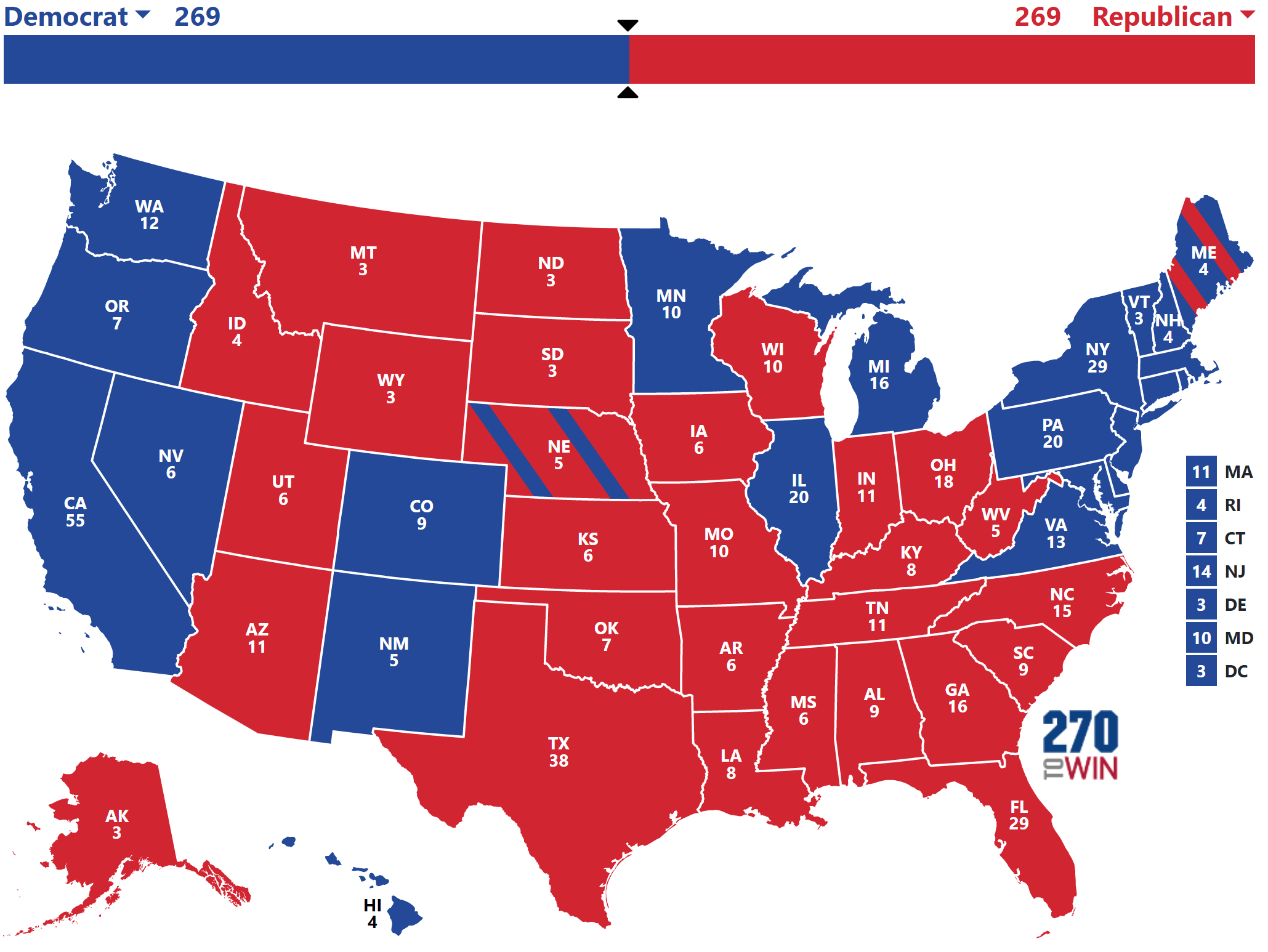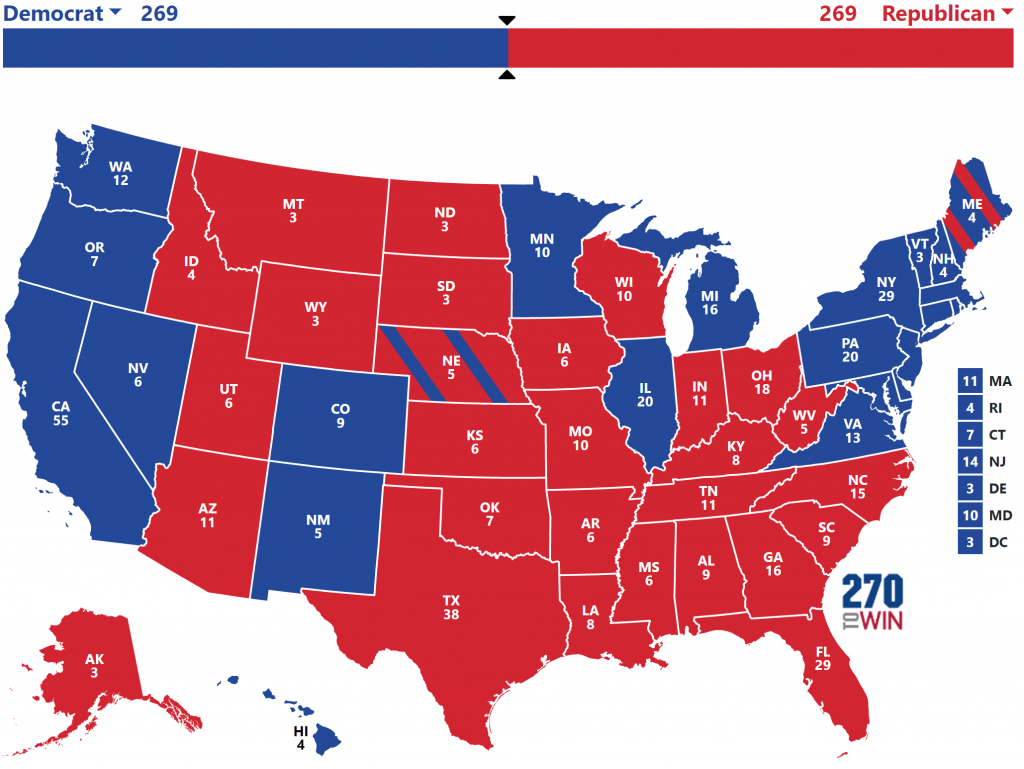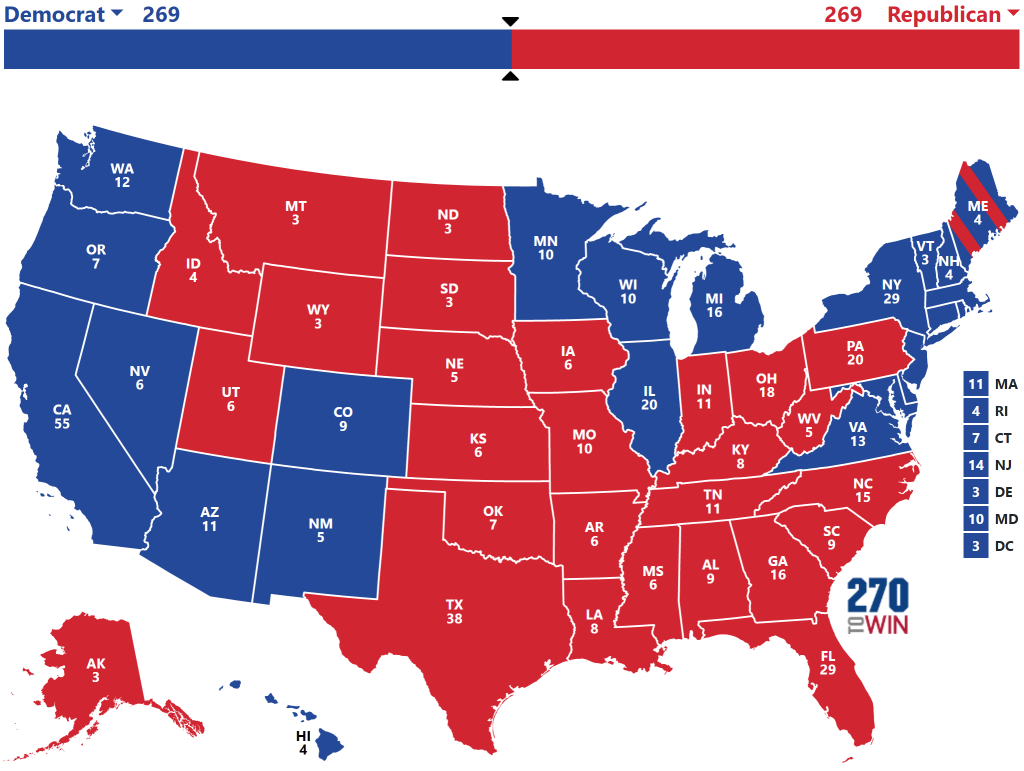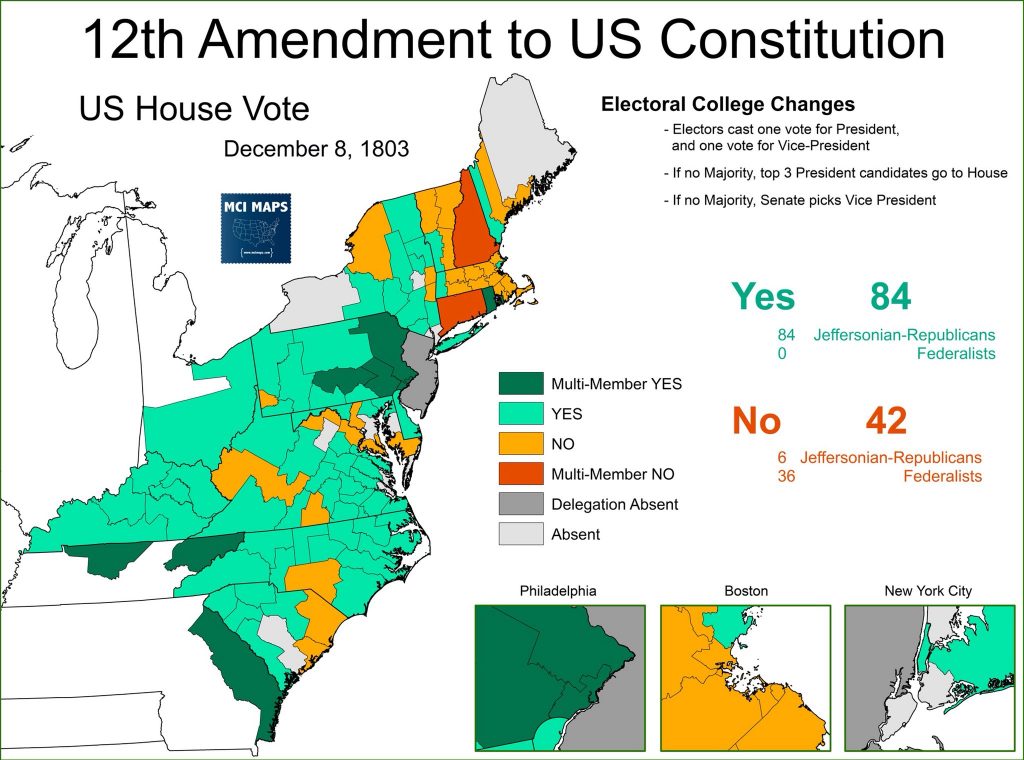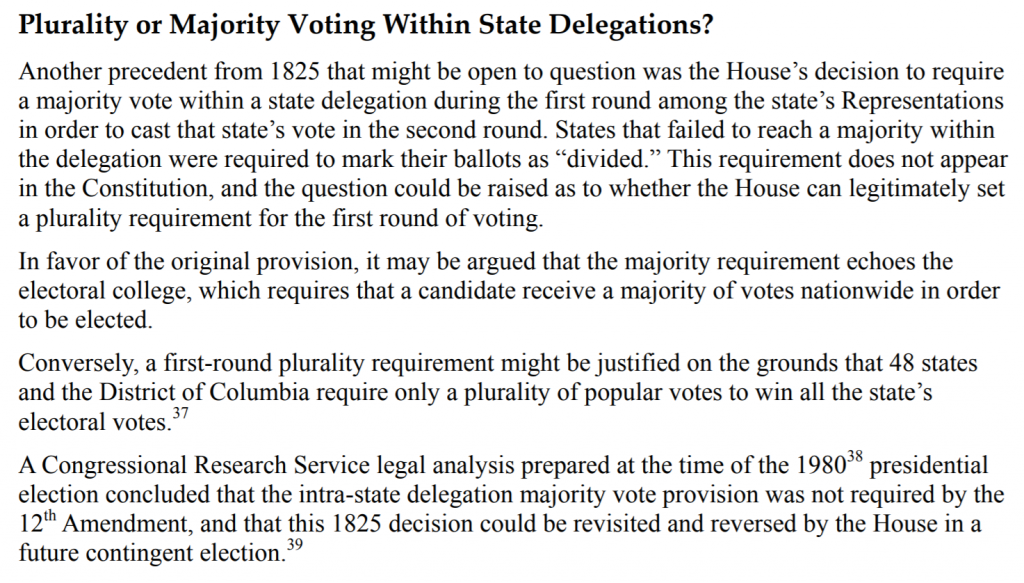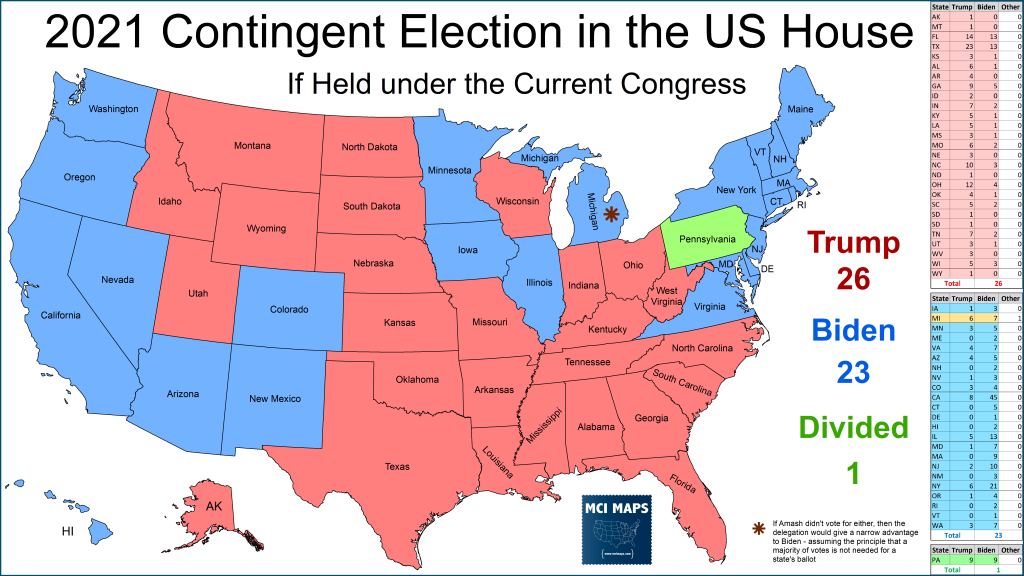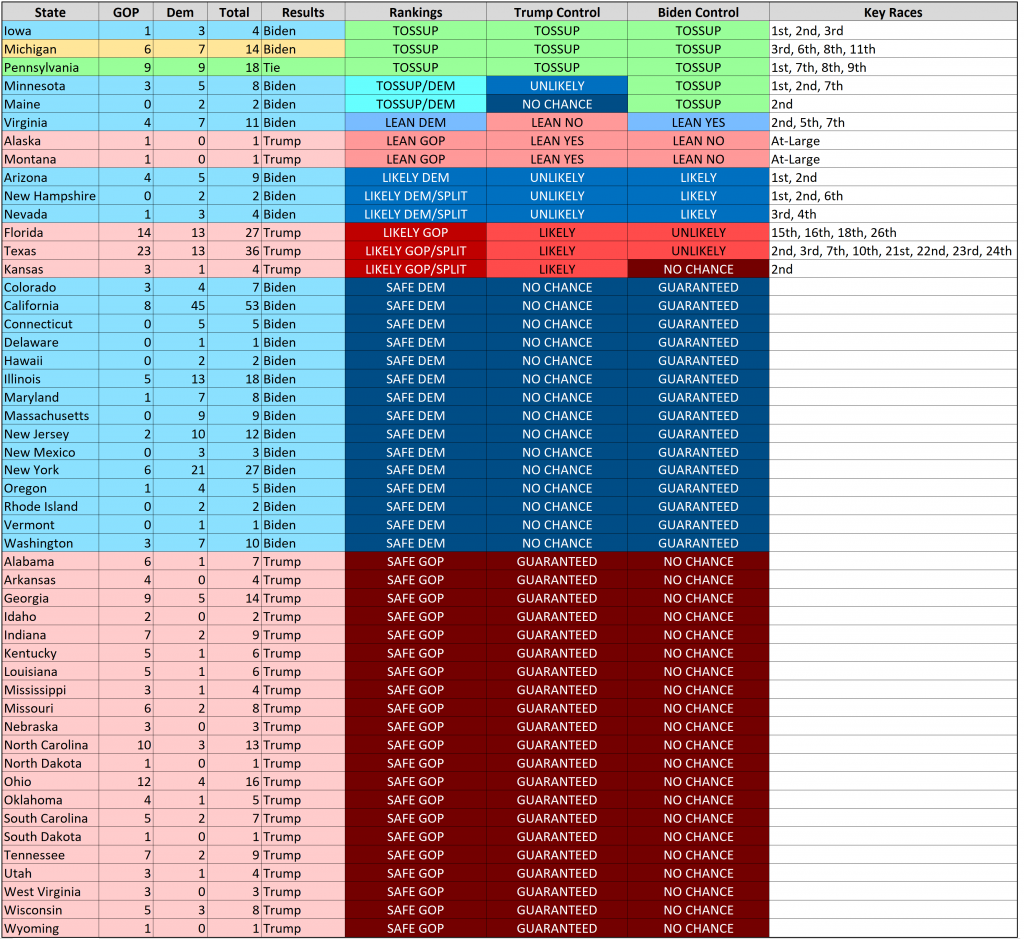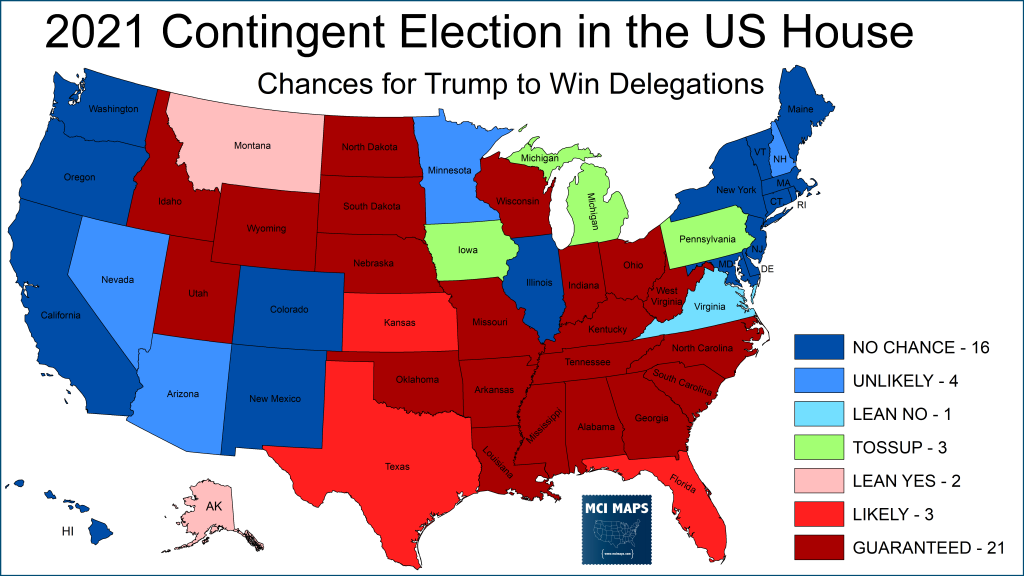(Note: An update to this rankings has been posted at the bottom to reflect the news out of the Minnesota 2nd district)
Plenty has been discussed about how either Joe Biden or Donald Trump can secure a majority in the electoral college this year. One item that has not been discussed as much is what happens if the electoral college’s 538 votes come down to a 269-269 tie.
How to Get a Tie
Based on current partisan leans in the electoral map, there are a few notable scenarios where Biden and Trump both get to 269 electoral votes.
A very realistic tie scenario could come down to Biden taking back Michigan and Pennsylvania from Trump, but failing to do so in Wisconsin or elsewhere. If Biden loses the Maine 2nd like Clinton, but gains the Nebraska 2nd; this would lead to a tie.
Another possible tie would involve Biden taking back Michigan and Wisconsin, but failing to take back Pennsylvania. Meanwhile, he takes Arizona – a state with continued DEM trends. This would lead to a tie as well.
Small variations in these maps could take place, especially flipping around the Maine 2nd and Nebraska 2nd and a few other states. In the end, a tie is a possible outcome of this election. So the question is, what happens next? The answer is a Contingent Election.
Procedures for a Contingent Election
The rules governing a contingent election are laid out in the US Constitution and have been revised via the 12th and 20th amendments. Under the original Constitution, if nobody got a majority of electoral votes, then the US House would pick from the top 5 candidates (in terms of electoral votes won, not popular vote). Each state would get one vote; with a majority of the delegation deciding among themselves who to give their vote to. To win the Presidency, a majority of state votes were needed. In a modern context, we have 50 states and thus 26 state votes would be needed.
A contingent election first occurred in the 1800 election; which saw Jefferson and Burr go through multiple ballots before a winner was decided. At the time, this was thanks to the rule that had electors cast two votes for President; and the 2nd place finisher becoming Vice President. Burr was supposed to the the VP, but miscommunication among electors led to the tie.
That issue was remedied with the 12th amendment, which set up a separate vote for Vice President by electors. The amendment also lowered the number of candidates the House would consider in a contingent election from 5 to 3. It likewise set up the Senate as the picker for the Vice President. A Senate vote would a simply majority of Senators. If the House failed to pick a President, than the Senate’s VP choice would become acting President.
After the the 12th amendment was ratified, a contingent election in the House was again needed; this time in 1824/25. This was the famous Jackson vs Adams vs Crawford vs Clay battle; which predictably saw no-one get a majority of electoral votes. An alliance between Adams and Clay gave Adams the Presidency.
Rules For a State Delegation’s Vote
Both of these elections took place over a century ago and both have a unique difference. The election of 1800 appears to have operated under a rule where state delegations could decide their vote by majority or plurality. This allowed Maryland to cast its votes for Jefferson despite having a delegation split at 4 Jeffersonians and 4 Federalists. At first these federalists were supporting Burr, however, Alexander Hamilton convinced them to allow Jefferson to win. The four federalists then left their ballots blank, allowing the 4 Jefferson voters to control the delegation. Technically these were not a majority of the delegation, just a majority of those voting.
However, in 1825, the rule was that a majority of the delegation was needed. This led to plenty of efforts by backers of Crawford to force split delegations to drag on a Jackson and Adams fight. However, the rule appears to have been set up by the house itself and is in constitutional or amendment text. See this excerpt from the Congressional Research Service.
So we should assume plurality delegation votes could be allowed. This is unlikely to matter much when the new Congress comes in. It would matter if Michigan Congressman Justin Amash (R now I) was running again. Amash’s current Independent status gives Democrats a 7-6-1 control of the delegation. If Amash voted for neither Biden or Trump, Biden would take the state delegation despite not having a majority (50%+1). If majority rules were used, he’d need 8/14 votes and Amash’s abstention would not matter.
When the Balloting Takes Place
It is also important to note another change from the last contingent election. Both House votes from the 1800 and 1824 contests where voted on by the Congress had been elected two years prior. This was back when the Congressional terms extended till March of the next year. However, the 20th amendment moved up Congressional and Presidential terms to January; severely shortening the lame duck timeline. While the text seems to not mention when the contingent election must be held, research shows the authors of the text aimed to move any contingent election to the newly elected Congress; which would be seated a few weeks before the Presidential term began. See this excerpt from the Congressional Research Service (and the footnotes).
So we should operate under the assumption that the results of these upcoming elections will determine the results of any contingent election.
Partisanship and Polarization
There is little reason to think that a contingent election held today would be be anything but a mirror image of the party control of the state delegations. Congresspeople would have no real incentive to defy their party; even at the risk of electoral damage in two years. Risks in the general would simply be replaced by risks in primaries. Not to mention, by and large most members sit in districts where the vote for Congress and vote for President will have similar, but not perfect, trends. There are a few exceptions but I will address these later.
The scholarly argument seems clear that any contingent election would be held by the next Congress. However, its still worth taking a look at where the current delegations stand. Under the current congress’ makeup (assuming all specials in Nov are held by the incumbent party), Trump would have 26 states, Biden 23, and 1 would be divided.
Under current delegation control, Trump has just enough states to assume the presidency from the House. Pence would likewise win a vote in the current US Senate. Now, lets take a look at the 2020 House Elections.
House Delegation Ratings
Looking ahead to this year’s congressional elections, the focus is not on which seats will flip; but rather if those flips will result in a delegation changing hands. I looked at all states and examined which districts are eyed as potentially on the board for flips this year. Based on rankings by various projectors, I ranked each state as follows.
Due to different goals and the possibility a delegation ties, there are a few ways of rankings in states. I looked at if either party could gain control of the delegation, or if the best that could be achieved is a split delegation. Keep in mind that for any candidate, a split is the same as opposition, because they need to get to 26 no matter what.
As the table shows, many states are on the table to see their delegation control change. However, Trump is at an advantage because he simply needs to hold his ground. Democrats can focus on two goals, however. They can focus on getting Biden over with 26 states, but that is a tough climb. What is much easier is getting Trump to 25 or less (with a few states split). The failure to secure a majority in the House would make the Senate’s VP pick the President – which could either be Harris (good for Democrats) or Pence (hey, better than Trump).
Would anyone defect from their Party?
These rankings and everything that follows assumes members of a party will vote for their party’s pick. While there would no doubt be pressure on a few members; especially if Democrats take Montana or Alaska while Trump wins it, there is a strong reason to assume they would not defect. This is not the 1970s, when there were huge numbers of liberal NE Republicans or Conservative Southern Democrats. The parties have drastically realigned since this time. Most major democratic candidates generally follow a left-of-center viewpoint. In addition, any vote for Trump would doom them in the party. Any vote for Trump would have to include a party switch to the GOP. While that cannot be ruled out entirely, we are going to operate as if that is a very unlikely scenario. Alaska’s Congressional race actually sees Democrats backing Independent Alyse Galvin; who could be up in the air in a contingent election. However, Montana’s Kathleen Williams is a former Democratic State lawmaker. Another option for any member is also a blank vote; which in cases like Montana or Alaska, is a vote to let the US Senate decide between Pence and Harris.
One special note – no Democrat will be under more pressure Minnesota Congressman Collin Peterson; who’s rural district is likely to back Trump with over 60%. However, if no flips happen in the Minnesota elections (and Peterson himself is in a tough fight) – even him voting for Trump would give the delegation a 4-4 tie; which doesn’t go for Biden, but also doesn’t go for Trump. A blank vote would also allow Biden to take Minnesota with a 4-3-1 plurality.
Trump’s Path to 26
Lets look at Trump’s path to 26 states. The rankings put him at 21 guaranteed, 3 likely, and 2 leaning his way. That gives him the 26 he needs.
His most difficult holds appear to be Montana and Alaska, where contested Congressional races are underway. Florida’s 14-13 delegation appears likely to hold, but isn’t a lock with several races on the ballot. Texas has a mountain of races up for grabs; but Democrats would need to flip 5 to tie the delegations. While that seems unlikely, the seats are on the board (4 especially) – so it wasn’t something I could rule out (especially as the suburbs of Texas continue to shift). Kansas is a perfect example of the win or tie scenario. The 2nd flipping would move the state to a 2-2 tie; costing him the state. However, Trump got a huge boost when scandal-plagued Incumbent Steve Watkins was primaried out; making a GOP hold much more likely.
Meanwhile, multiple states are tossups and if the GOP could flip two swing seats in Virginia; Trump would take it. The Virginia 2nd and 7th are both rated Tossup or Lean Dem; but Trump needs the GOP to take both. Delegations in Nevada, New Hampshire, and Arizona have the possibility to flip, but are unlikely at this point.
Biden’s Path to 26
The chances for Biden in the house are much more precarious than they are for Trump. Two additional delegations become tossups; Maine and Minnesota – where losses in the 7th or 2nd would result in splits. Biden is guaranteed 15 states, is likely in 3 more, leans in 1, and their are 5 total tossups.
Biden would need Democrats to win all the tossups and Montana and Alaska to get to 26. Winning the tossups means not losing an seats in Iowa, Minnesota, Maine – and netting seats out of Pennsylvania and Michigan.
For Democrats, the more realistic scenario is simply trying to deprive Trump of a win in the House; throwing it to the Senate.
Senate Procedures
The procedures for the US Senate are much less convoluted than the House. We have 100 Senators, and 51 votes gets you the Vice Presidency. In a tie, the current Vice President would presumably be the tie-breaker. So yes, this does lead to a scenario where a 50-50 tie from the elections leads to outgoing Vice President Mike Pence casting a ballot for himself to remain on the job. Of course, if the House has failed to pick a President, this would make him the acting President as a result.
Right now, the Senate stands at 53 Republicans, 47 Democrats. To get Harris as VP (or President), Democrats must net four seats. This will be a tough haul itself; as Alabama Democrat Doug Jones is going to struggle to win re-election. Democrats have good chances to take flip Colorado, Arizona, Maine, and North Carolina. If they can hold Alabama, or replace it with Montana, Georgia, Iowa, or Alaska; they can get to 51 – which would allow Harris to win.
Conclusion
So…. how likely is any of this? The map logic is sound – and all it takes is a few states going a specific way. 5%? I’m not a forecaster. But the chance is there. The question then becomes, does anyone get to 26 delegations in the house? Who wins the VP vote in the Senate? It is also entirely possibly a Trump win in the House could be paired with a Harris VP win. How about a Trump-Harris administration?
Can’t rule it out.
Updated! Minnesota’s 2nd District changes the math
A sad and legally-bizarre situation emerged today (September 24th) in Minnesota’s 2nd Congressional district. Adam Weeks, a candidate for the “Legal Marijuana Now” Party, has passed away. As a result, Minnesota law dictates that the regularly scheduled general election for the 2nd district is CANCELLED and a special election will take place in February. While most states simply allow parties to pick replacement nominees, the MN law voids an election if a “major party” candidate dies so close to the election.
So why is the “Legal Marijuana Now” Party considered a major party? Because a candidate under their banner got over 5% of the vote in a 2018 Minnesota statewide race. In this case, it was the race for State Auditor.
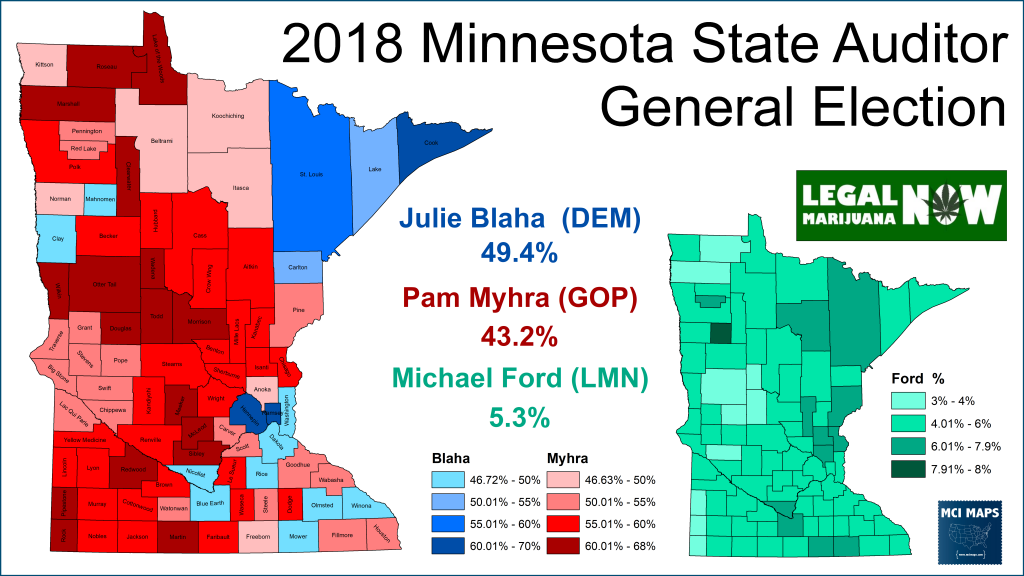
The pushing of the election means that when the new Congress is seated in January, the 2nd district will become vacant. Since the seat is held by Democrat Angie Craig, that is one less Democrat available to be part of the the state delegation if the Presidential contest goes to the US House. Craig was viewed as likely to hold her seat in November.

This means the delegation will be 7 members, not 8, when a contingent election take’s place. Originally, it was viewed that the best GOP pickup opportunity would be the 7th district, Represented by Collin Peterson despite Trump taking over 60% in the district in 2016.

Peterson held on by 4% in 2018 and the GOP is gunning for his district. He has managed to hold on in this agriculture-heavy district thanks to his connections to and understanding of farming community (and he’s chair of the Agriculture Committee in the House). Current rankings put it at a tossup. If the GOP flips the 7th, it would give them a 4-3 lead in the delegation; giving Trump the state’s vote. Before this issue with the 2nd arose, the flip would have meant just a 4-4 tie and no one winning the state. As I laid out in my main article, for Trump a tie is the same as a NO – one less vote getting him to the 26 states he needs.
I already had Biden’s ranking for the state at tossup because a 4-4 wouldn’t help him either. Trump’s ranking in the state was “unlikely” since a 2nd flip would be needed. Now it moves to “Tossup.”
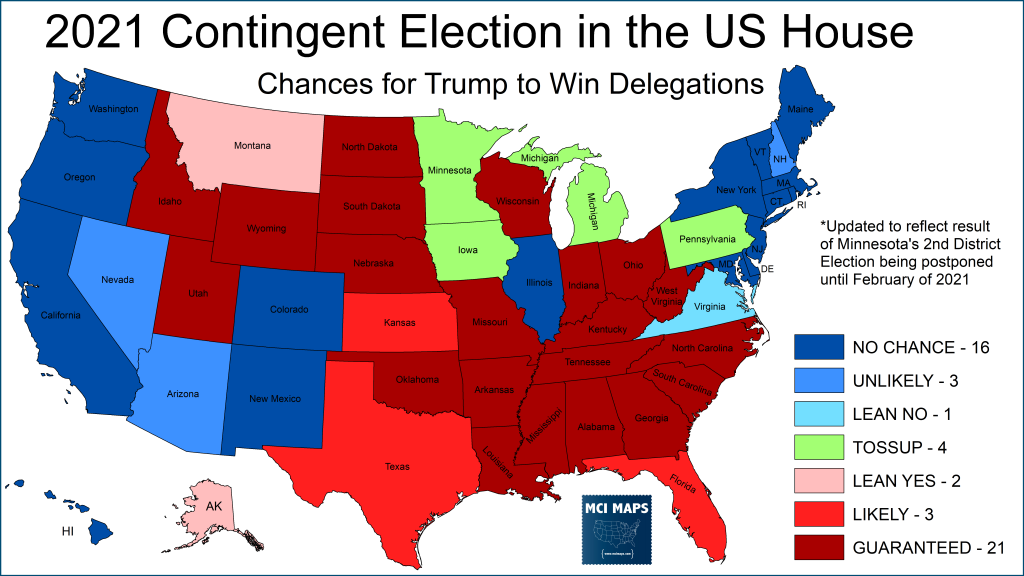
There is some speculation about a quick legal challenge to this law and if it passes federal muster. After all, elections are supposed to be wrapped up for the new Congress. This is a unique scenario and I’m not sure if we have good legal precedent here. Keep your eyes open for any challenges.
There is one other intriguing issue. At least theoretically, the House’s contingent election has no set date. Of course it is supposed to happen before any inauguration timeline – but I am not sure anything would stop Speaker Pelosi (assuming Democrats hold the house) from simply insisting the House vote be delayed until the special election. The only scenario where this is likely possible is if Trump needs Minnesota to get to 26 delegations and the MN-07 has gone to the GOP. A delay past inauguration would mean the Senate’s VP choice would be acting-President in the meantime. By delaying the vote and hoping Democrats hold the 2nd in the special, a 4-4 tie would mean no Minnesota vote – hence no house majority for Trump – hence the VP chosen by the Senate remains President. This would also put tremendous pressure on the 2nd district special election – a seat Trump won 46%-45% but went much bluer in 2018.
We will keep an eye out to see if any legal challenges emerge out of the 2nd. In the meantime, this has opened up even more uncertainty if an electoral tie occurs.

